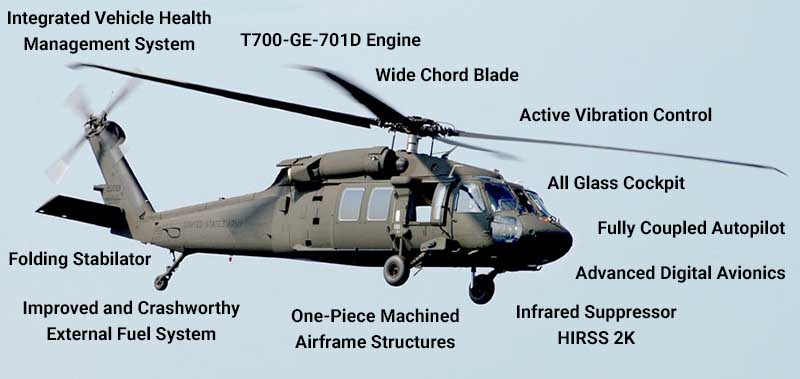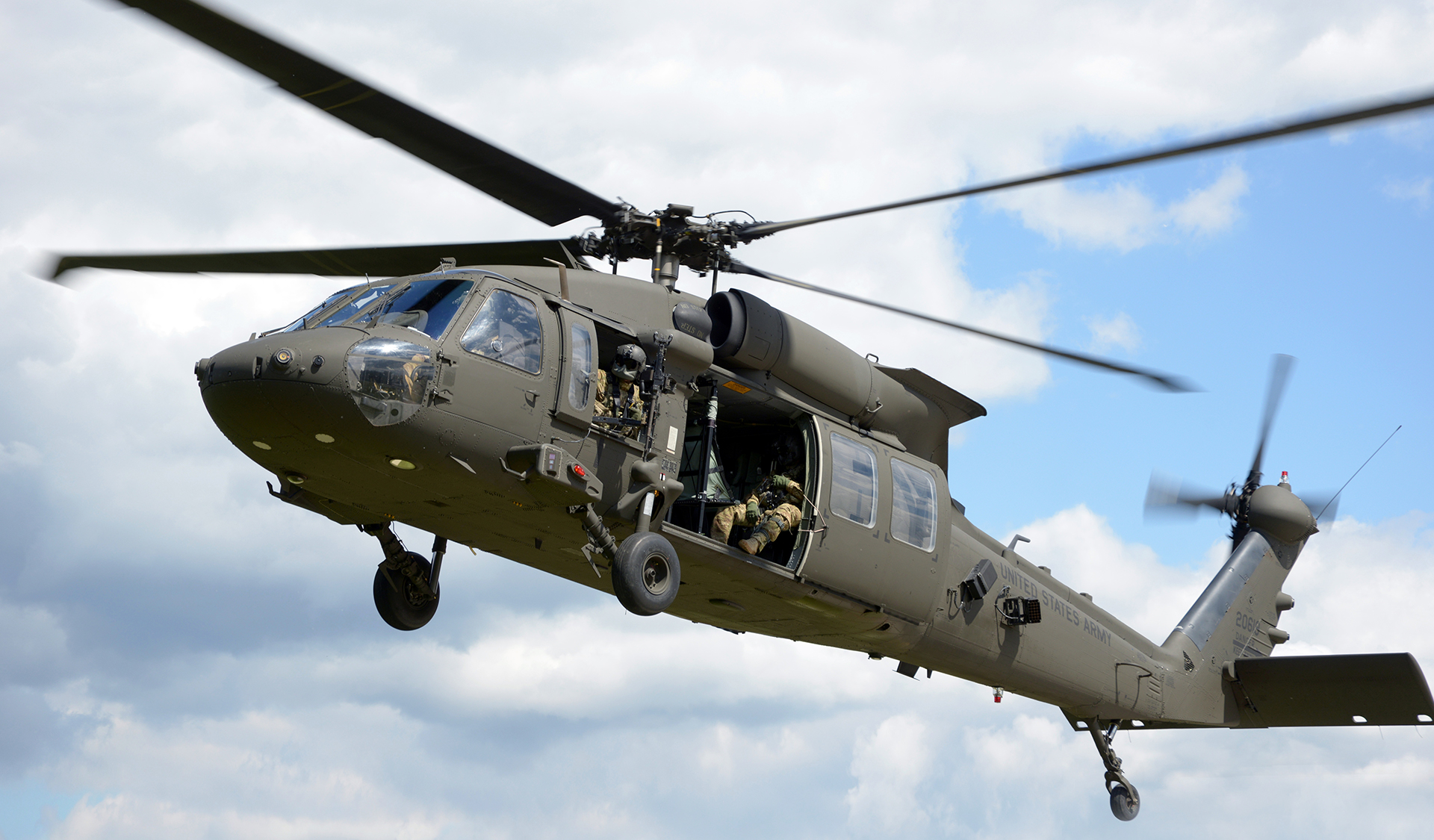The Advancement of the UH 60: From Its Beginning to Modern-Day Enhancements
The Advancement of the UH 60: From Its Beginning to Modern-Day Enhancements
Blog Article
UH-60: Advancements in Modern Helicopter Layout
The UH-60 helicopter stands as a criteria in modern air travel, showcasing considerable improvements in style and technology that satisfy the evolving demands of armed forces procedures. Its unification of advanced materials not just enhances performance however additionally addresses vital safety and security issues. The integration of sophisticated avionics has actually changed operational abilities, allowing for greater situational awareness and decision-making efficiency. As we explore the development and vital advancements of the UH-60, it becomes important to consider how these developments influence not just current applications yet also the future landscape of helicopter design.

Evolution of the UH-60
The development of the UH-60 Black Hawk helicopter represents a considerable turning point in aerospace design and armed forces aviation. Presented in the late 1970s, the UH-60 was made by Sikorsky Aircraft to meet the United States Military's demand for a flexible energy helicopter efficient in executing a variety of objectives. Its design stressed ability to move, rate, and resilience, establishing brand-new standards for functional performance.
The UH-60 features an unique four-blade rotor system, which improves lift and stability, allowing it to run properly in varied environments. Its airframe is built from advanced composite products, adding to a decrease in weight while maintaining structural integrity. The helicopter's style likewise includes enhanced the rules of aerodynamics, which boosts gas efficiency and enhances variety.
For many years, the Black Hawk has gone through multiple upgrades to enhance its capacities, including enhanced engines, progressed trip control systems, and modular systems for very easy maintenance and versatility. The helicopter's capability to perform goals varying from troop transportation to clinical evacuation has solidified its duty as a backbone of U.S. army procedures. The UH-60 Black Hawk continues to be an archetype of exactly how technology in helicopter layout can significantly affect military effectiveness and functional adaptability.
Advanced Avionics Equipments
Improvements in avionics systems have transformed the capacities of modern-day helicopters like the UH-60 Black Hawk, boosting functional performance and situational recognition (UH 60). The integration of innovative avionics permits boosted interaction, flight, and navigation management, making the UH-60 extra flexible in varied mission accounts
One of the vital functions is the sophisticated digital cockpit, which employs multifunction display screens that supply real-time data, guaranteeing pilots have instant access to vital trip info. This streamlining of details minimizes pilot work and enhances decision-making procedures during complex procedures. Additionally, the consolidation of general practitioner and inertial navigating systems enables precise positioning and path planning, enhancing mission implementation in tough environments.
Moreover, progressed avionics systems enhance interaction capacities via safe data links and voice communication systems, allowing seamless control with ground forces and various other airplane. The assimilation of automatic trip control systems additionally contributes to boosted security and control, particularly in negative climate conditions or during low-altitude maneuvers.
Engine and Efficiency Enhancements
Engine performance in modern helicopters has taken a significant leap forward, driven by advancements that boost efficiency, power, and dependability. The UH-60 Black Hawk, for instance, uses the T700-GE-701C engine, which features a dual-channel, full-authority electronic engine control system.
Additionally, the assimilation of engine wellness surveillance systems enables real-time diagnostics and predictive upkeep, significantly boosting operational integrity. These systems not just alert staffs to possible issues prior to they come to be important yet also help with a lot more reliable upkeep scheduling, thus reducing downtime.

Materials and Structural Innovations
Current developments in materials and structural design have actually transformed contemporary helicopter building and construction, enhancing both efficiency and sturdiness. The introduction of sophisticated composite materials, such as carbon fiber strengthened polymers, has substantially reduced weight while maintaining structural stability. This change not just improves gas effectiveness but also enhances payload ability, allowing helicopters like the UH-60 to execute even more diverse missions.
In addition, innovations in aluminum alloys and titanium parts have actually added to enhanced resistance to corrosion and tiredness, prolonging the lifespan of important airframe aspects. The strategic use these products has led to a reduction in upkeep demands see and enhanced general operational preparedness.

Furthermore, the assimilation of computer-aided layout (CAD) and additive production technologies has actually allowed much more light-weight structures and intricate geometries, optimizing the aerodynamic efficiency of helicopter layouts. These developments help with rapid prototyping and manufacturing, enabling manufacturers to react quickly to advancing goal needs.
Safety And Security and Survivability Attributes
Security and survivability attributes in modern helicopter style have actually become extremely important, showing the boosting needs for goal performance in challenging environments. The UH-60 Black Hawk, a noteworthy instance, incorporates sophisticated modern technologies to boost team and passenger protection. One of one of the most essential improvements is the incorporation of crashworthy gas systems designed to minimize the risk of fire during effect. In addition, the airframe is built with enhanced materials that dissipate and take in power, additional safeguarding occupants in the event of an accident.
The helicopter likewise utilizes a ballistic protection system, which consists of armored staff seats and crucial systems securing, lowering susceptability to tiny arms fire and shrapnel. Improved situational recognition is attained via advanced avionics and sensing unit innovations, allowing pilots to find and avoid hazards efficiently.
Furthermore, the assimilation of redundancy in essential systems-- such as double engines and numerous flight control networks-- makes certain ongoing procedure even if one system falls short. The UH-60 is equipped with innovative emergency flotation protection devices, boosting survivability in water touchdowns. Collectively, these attributes not only boost the safety of personnel however likewise raise mission success prices in aggressive environments, demonstrating the dedication to quality in helicopter design.
Final Thought
The UH-60 helicopter stands for a considerable improvement in modern aviation innovation, incorporating ingenious products, innovative avionics, and robust safety and security features. In general, the UH-60 serves as a benchmark for future developments in helicopter design, embodying durability and flexibility in modern army operations.
The UH-60 helicopter stands as a benchmark in modern-day aviation, showcasing significant innovations in layout and technology that cater to the advancing needs of armed forces procedures. As we explore the development and crucial advancements of the UH-60, it becomes important to take into consideration exactly how these growths influence not only current applications yet likewise the future landscape of helicopter design.
Introduced in the late 1970s, the UH-60 was designed by Sikorsky Aircraft to fulfill the United States Military's need for a functional energy helicopter capable of carrying helpful resources out a variety of goals. The UH-60 Black Hawk continues to be a prime example of how development in helicopter design can substantially affect military efficiency and operational adaptability.
Generally, the UH-60 serves as a benchmark for future why not find out more developments in helicopter style, embodying strength and flexibility in modern armed forces operations.
Report this page